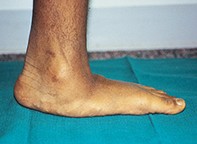Peer Reviewed
Feature Article Podiatry
Adult onset flatfoot: a guide to posterior tibial tendon dysfunction
Abstract
A common cause of adult onset flatfoot deformity is dysfunction of the posterior tibial tendon. Early recognition of this dysfunction is important because of its progressive nature. Nonoperative and operative treatment options depend on the severity of the symptoms and the stage of the disease.
Key Points
- The diagnosis of posterior tibial tendon dysfunction is based on a thorough history, examination of the foot and plain radiographs.
- In the early stages of posterior tibial tendon dysfunction, the patient will describe an insidious onset of fatigue and vague aching on the medial side of the foot and ankle, which are aggravated by activity. Swelling is common if the dysfunction is associated with tenosynovitis.
- With increasing deformity, patients or their relatives and friends may notice a change in the shape of the foot and that it becomes increasingly difficult to wear shoes.
- Both feet should be examined with the patient standing. Observe the alignment of the foot and ankle, and look for any asymmetrical swelling, flattening of the medial longitudinal arch and forefoot abduction.
- Nonoperative treatment (use of orthotics and shoe modification) should be tried first. If this fails, several surgical procedures are available depending on the stage of the disease.
Purchase the PDF version of this article
Already a subscriber? Login here.

